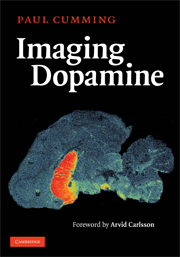Book contents
- Frontmatter
- Contents
- Foreword
- Acknowledgments
- Introduction
- 1 The life history of dopamine
- 2 Enzymology of tyrosine hydroxylase
- 3 The assay of tyrosine hydroxylase
- 4 Enzymology of aromatic amino acid decarboxylase
- 5 PET studies of DOPA utilization
- 6 Conjugation and sulfonation of dopamine and its metabolites
- 7 Dopamine synthesis and metabolism rates
- 8 MAO activity in the brain
- 9 Vesicular storage of dopamine
- 10 Dopamine release: from vesicles to behavior
- 11 The plasma membrane dopamine transporter
- 12 Dopamine receptors
- 13 Imaging dopamine D1 receptors
- 14 Imaging dopamine D2 receptors
- 15 Factors influencing D2 binding in living brain
- 16 The absolute abundance of dopamine receptors in the brain
- 17 Conclusions and perspectives
- References
- Index
- Plate section
8 - MAO activity in the brain
Published online by Cambridge University Press: 04 December 2009
- Frontmatter
- Contents
- Foreword
- Acknowledgments
- Introduction
- 1 The life history of dopamine
- 2 Enzymology of tyrosine hydroxylase
- 3 The assay of tyrosine hydroxylase
- 4 Enzymology of aromatic amino acid decarboxylase
- 5 PET studies of DOPA utilization
- 6 Conjugation and sulfonation of dopamine and its metabolites
- 7 Dopamine synthesis and metabolism rates
- 8 MAO activity in the brain
- 9 Vesicular storage of dopamine
- 10 Dopamine release: from vesicles to behavior
- 11 The plasma membrane dopamine transporter
- 12 Dopamine receptors
- 13 Imaging dopamine D1 receptors
- 14 Imaging dopamine D2 receptors
- 15 Factors influencing D2 binding in living brain
- 16 The absolute abundance of dopamine receptors in the brain
- 17 Conclusions and perspectives
- References
- Index
- Plate section
Summary
Enzymology
The oxidative deamination of dopamine and other monoamines is catalyzed by two distinct forms of MAO with high sequence homology (MAO-A, MAO-B), the genes of which have both been localized to nearby bands on the X-chromosome (Kochersperger et al. 1986). The deduced amino acid sequences for the enzymes expressed in human liver predict molecular weights close to 59 000 for both forms, and contain a C-terminus alpha helix which is the likely site of fixation in membranes (Bach et al. 1988). The two genes share considerable homology and have the same intron–exon structure, suggesting an ancient duplication event of the ancestral gene (Grimsby et al. 1991). Consistent with their ancient origin, the amino acid sequences have considerable homology across species, especially in the domain containing the cystein residue which binds the prosthetic flavin adenine dinucleotide (FAD) (Kwan, Bergeron, & Abell 1992). The pure enzyme is devoid of iron or other transition metal ions. The catalytic cycle for MAO involves the successive binding of the amine substrate and oxygen, followed by liberation of the aldehyde product and equimolar amounts of ammonia and hydrogen peroxide. In general, the aldehyde produced by MAO is immediately oxidized further by non-specific enzymes, yielding a carboxylic acid, hence the acidic metabolites of dopamine. The production of (toxic) hydrogen peroxide may be problematic under certain circumstances, especially given the location of MAO in the outer mitochondrial membrane.
- Type
- Chapter
- Information
- Imaging Dopamine , pp. 99 - 110Publisher: Cambridge University PressPrint publication year: 2009



